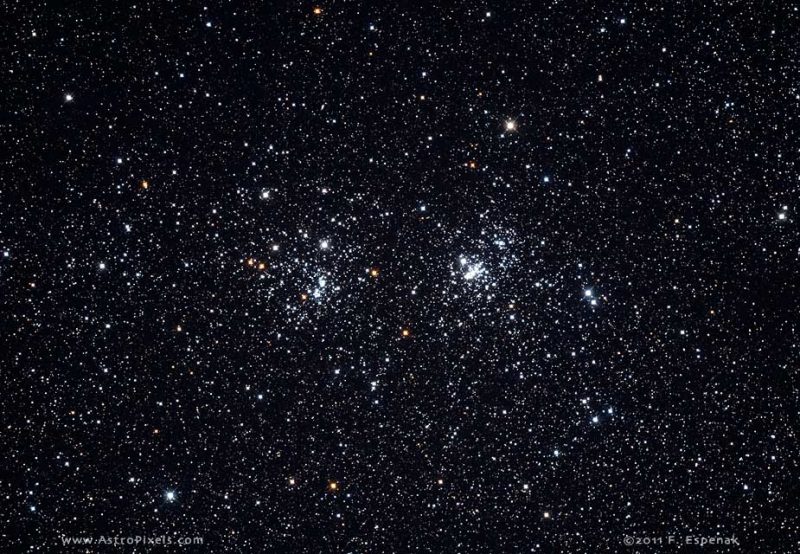Tonight, find the gorgeous Double Cluster in the constellation Perseus. It’s a wonderful sight to see, assuming your sky is dark. To see it at this time of year, face north to northwest as darkness falls. The Double Cluster consists of two open star clusters, known as H and Chi Persei (also called NGC 884 and 869).
How to find them? First, you really do need that dark sky. Second, you might need binoculars, as the Double Cluster is only faintly visible to the unaided eye, even on an inky black night. Look for the famous constellation Cassiopeia the Queen in the northwest, forming a backwards “3,” or perhaps an “E,” or the letter “M” or “W” turned on its side.
Just above Cassiopeia, assuming your sky is dark enough, you’ll see a faint fuzzy patch. This is the Double Cluster, which blooms into a sparkling array of stars through binoculars or a small backyard telescope.

Finding the Double Cluster with the constellation Cassiopeia. Image via madmiked/ Flickr.
These two open star clusters reside an estimated 7,400 light-years away. Each contains 300 to 400 stars. These stars are thought to be approximately three million years old … babies in star time! The stellar gas and the myriad stars that compose the flat disk of our Milky Way galaxy pass right through Cassiopeia and Perseus – and in front and behind the Double Cluster. If your sky is dark enough, you’ll see the hazy pathway of the winter Milky Way crossing this part of the sky.
The Double Cluster was charted by skywatchers as early as 150 B.C. Hipparchus saw it, and Ptolemy named it as one of seven “nebulosities” in the Almagest, an ancient astronomy text used for over a millennium. The Double Cluster in Perseus ranks as a favorite among stargazers, a bejeweled place in the heavens to zoom in on with binoculars.
Read more: Double Cluster in Perseus
Enjoying EarthSky so far? Sign up for our free daily newsletter today!

The Double Cluster in Perseus. Photo by Fred Espenak. More details about the cluster and this photo.
Bottom line: Face the northwestern horizon as darkness falls on winter evenings to find the Double Cluster in the constellation Perseus.
Donate: Your support means the world to us
from EarthSky https://ift.tt/37MGJcr
Tonight, find the gorgeous Double Cluster in the constellation Perseus. It’s a wonderful sight to see, assuming your sky is dark. To see it at this time of year, face north to northwest as darkness falls. The Double Cluster consists of two open star clusters, known as H and Chi Persei (also called NGC 884 and 869).
How to find them? First, you really do need that dark sky. Second, you might need binoculars, as the Double Cluster is only faintly visible to the unaided eye, even on an inky black night. Look for the famous constellation Cassiopeia the Queen in the northwest, forming a backwards “3,” or perhaps an “E,” or the letter “M” or “W” turned on its side.
Just above Cassiopeia, assuming your sky is dark enough, you’ll see a faint fuzzy patch. This is the Double Cluster, which blooms into a sparkling array of stars through binoculars or a small backyard telescope.

Finding the Double Cluster with the constellation Cassiopeia. Image via madmiked/ Flickr.
These two open star clusters reside an estimated 7,400 light-years away. Each contains 300 to 400 stars. These stars are thought to be approximately three million years old … babies in star time! The stellar gas and the myriad stars that compose the flat disk of our Milky Way galaxy pass right through Cassiopeia and Perseus – and in front and behind the Double Cluster. If your sky is dark enough, you’ll see the hazy pathway of the winter Milky Way crossing this part of the sky.
The Double Cluster was charted by skywatchers as early as 150 B.C. Hipparchus saw it, and Ptolemy named it as one of seven “nebulosities” in the Almagest, an ancient astronomy text used for over a millennium. The Double Cluster in Perseus ranks as a favorite among stargazers, a bejeweled place in the heavens to zoom in on with binoculars.
Read more: Double Cluster in Perseus
Enjoying EarthSky so far? Sign up for our free daily newsletter today!

The Double Cluster in Perseus. Photo by Fred Espenak. More details about the cluster and this photo.
Bottom line: Face the northwestern horizon as darkness falls on winter evenings to find the Double Cluster in the constellation Perseus.
Donate: Your support means the world to us
from EarthSky https://ift.tt/37MGJcr

Aucun commentaire:
Enregistrer un commentaire